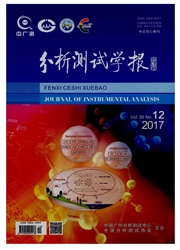

 中文摘要:
中文摘要:
基于浓度参量同步荧光光谱技术,对不同溢油类型不同油源原油样品集、引入外扰相似油源样品集进行光谱数据采集,获取其浓度同步荧光光谱矩阵Concentration-Synchronous-Matrix-Fluorescence (CSMF),利用主成分分析方法对两套不同层次的原油相关样品集进行了多类分类识别.结果表明:主成分载荷图可以很好地反映各个原油相关样品在油源上的相似程度,结合支持向量机可以实现不同溢油类型及不同油源原油的准确分类,对于引入风化和海水外扰相似油源溢油样品集,两类分类区分的结果远远高于多类分类识别的结果.通过详细的主成分分析讨论,为溢油油种鉴别提供了一种利用多类分类识别,逐步缩减嫌疑样本数量,最后通过两两分类实现溢油样品准确识别的新思路.
 英文摘要:
英文摘要:
In this paper, Concentration - Synchronous - Matrix - Fluorescence Spectroscopy (CSMF) was applied to characterize the chemical fingerprint information more comprehensively by adding con- centration as a new dimension to fluorescence spectroscopy. Two tiered petroleum related sample sets (including the different spill oil types and different source crude oil sample set, and the closely-relat- ed source sample set with disturbance of weathering and seawater adulteration) were analyzed by prin- cipal component analysis(PCA). The results showed that for the crude oil samples from China, the weathering have no significant effect on the CSMF, and the PCA can classify the samples into differ- ent oil types in the principal components space according to the oil heaviness. Support Vector Ma- chine (SVM) , along with Leave - One - Out Cross - Validation, was used for confirmation of the va- lidity of this method. 100% accuracy was obtained for the different spill oil types and different source crude oil sample set, and 77% accuracy was for the closely-related source sample set with disturb- ance of weathering and seawater adulteration. Detailed discussion indicated that pair-wise classifica- tion, can acquire higher accuracy than multi classification, and a tiered classification method from multi classification of different oil spill types to pair-wise classification of closely-related crude oil is then recommended for oil species identification. All the results suggested that the CSMF can be used as a rapid and reliable detection and characterization method for petroleum oil contaminants.
 同期刊论文项目
同期刊论文项目
 同项目期刊论文
同项目期刊论文
 Studies on rotational spectra of the ground states of ZnO, ZnS, SiSe and SiTe isotopic molecules usi
Studies on rotational spectra of the ground states of ZnO, ZnS, SiSe and SiTe isotopic molecules usi Trace analysis of polycyclic aromatic hydrocarbons using calixarene layered gold colloid film as sub
Trace analysis of polycyclic aromatic hydrocarbons using calixarene layered gold colloid film as sub An improved self-assembly gold colloid film as surface-enhanced Raman substrate for detection of tra
An improved self-assembly gold colloid film as surface-enhanced Raman substrate for detection of tra 期刊信息
期刊信息
